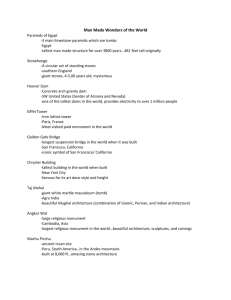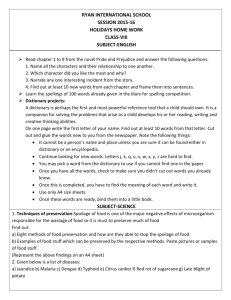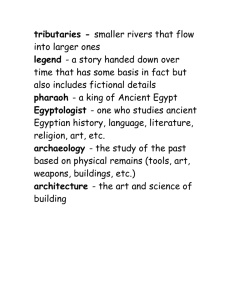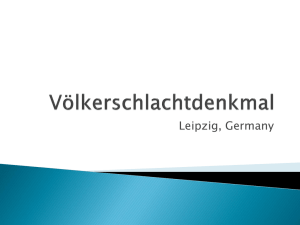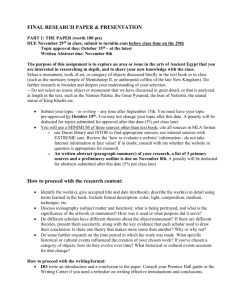Course Information: Type: Level: Colorado College
advertisement
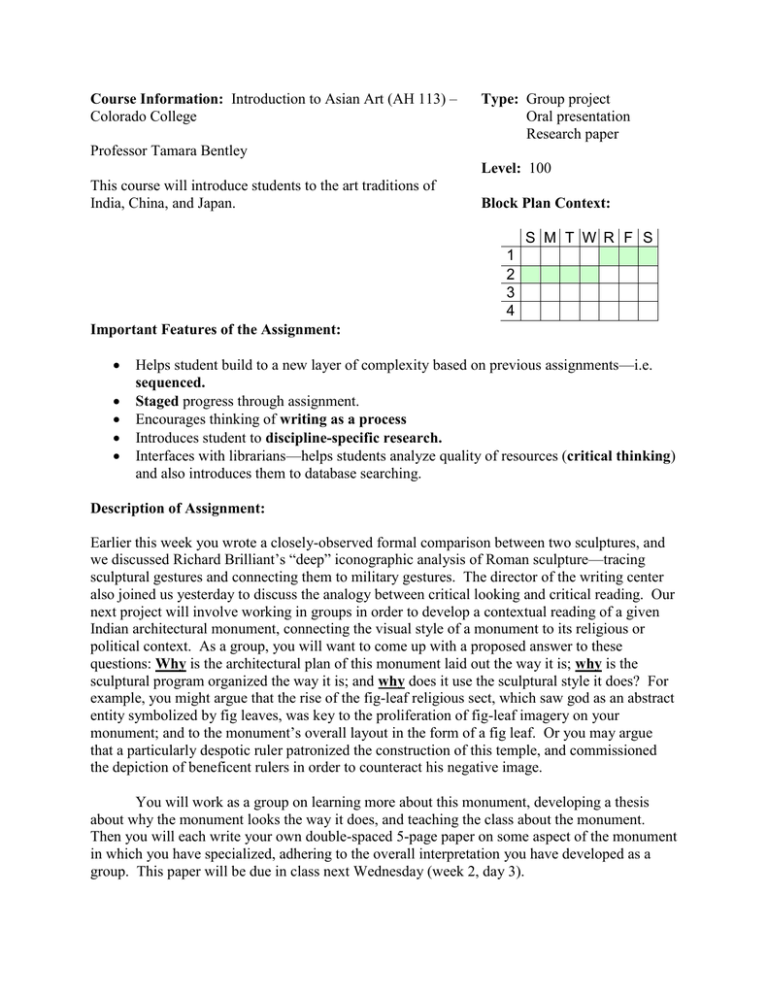
Course Information: Introduction to Asian Art (AH 113) – Colorado College Type: Group project Oral presentation Research paper Professor Tamara Bentley Level: 100 This course will introduce students to the art traditions of India, China, and Japan. Block Plan Context: S M T W R F S 1 2 3 4 Important Features of the Assignment: Helps student build to a new layer of complexity based on previous assignments—i.e. sequenced. Staged progress through assignment. Encourages thinking of writing as a process Introduces student to discipline-specific research. Interfaces with librarians—helps students analyze quality of resources (critical thinking) and also introduces them to database searching. Description of Assignment: Earlier this week you wrote a closely-observed formal comparison between two sculptures, and we discussed Richard Brilliant’s ―deep‖ iconographic analysis of Roman sculpture—tracing sculptural gestures and connecting them to military gestures. The director of the writing center also joined us yesterday to discuss the analogy between critical looking and critical reading. Our next project will involve working in groups in order to develop a contextual reading of a given Indian architectural monument, connecting the visual style of a monument to its religious or political context. As a group, you will want to come up with a proposed answer to these questions: Why is the architectural plan of this monument laid out the way it is; why is the sculptural program organized the way it is; and why does it use the sculptural style it does? For example, you might argue that the rise of the fig-leaf religious sect, which saw god as an abstract entity symbolized by fig leaves, was key to the proliferation of fig-leaf imagery on your monument; and to the monument’s overall layout in the form of a fig leaf. Or you may argue that a particularly despotic ruler patronized the construction of this temple, and commissioned the depiction of beneficent rulers in order to counteract his negative image. You will work as a group on learning more about this monument, developing a thesis about why the monument looks the way it does, and teaching the class about the monument. Then you will each write your own double-spaced 5-page paper on some aspect of the monument in which you have specialized, adhering to the overall interpretation you have developed as a group. This paper will be due in class next Wednesday (week 2, day 3). You will develop your group presentation and your individual paper by way of a series of steps. Step 1. For the last hour-and-a-half of class today (week 1, thursday) we will go to Tutt library for a one-hour introduction to library and electronic resources, including interlibrary loan and the EBSCO database, with Krystyna Mrozek, interdisciplinary programs librarian. Following this orientation, you will need to find at least two articles and two books which address your monument, either in whole or in part. Obtain these sources (i.e. if you find a relevant article you must download or photocopy it) and bring them to class with you tomorrow (Friday). As a group, you also need to hand in a single one-page bibliography listing each of these sources in the Kate Turabian bibliographic format. Friday Krystyna will join us and she and Tamara will discuss the merits, or limitations, of the sources you have found; and Krystyna will demonstrate the use of additional databases for finding books and articles on your topic. Some of you may also want to make an appointment to meet with Krystyna Mrozek in the afternoon for more help finding sources. Reference librarians are also available at the Tutt library reference desk over the weekend. Step 2. Alongside your research project, divide up the chapters of the short book Darsan: Seeing the Divine in Indian Art among your group. Meet preferably Saturday morning at the library to share with each other the overall points of the chapters you read. Step 3. Regarding your research project, over the weekend (preferably Saturday afternoon or Sunday morning) find at least 3 more sources that address your monument (you need at least 7 sources total). Now that you have found these sources, it is time to read them. Decide how the group will read and summarize these sources. Do you all read everything? Do you divide up readings? In addition, how might you divide up coverage of the monument for your presentations? One division of labor might be the following: one person handles the sculptural program, one person handles the architectural design, and one person handles political or religious issues--or subtopics of that nature. You will need to continue meeting regularly and informing each other on your separate pieces, so that you can ultimately knit together your various aspects, forming a multi-faceted contextual interpretation of the temple or palace. Step 4. Monday morning hand in an annotated bibliography and a two-page rough draft on your section of the analysis. Bonnie Stapleton will talk with you about how to organize effective oral presentations. Class is dismissed early. Meet with Tamara in order to pull slides for your presentation and go over your proposed plan for the presentation. Prepare your presentation in consultation with each other. Consider preparing handouts. Optimally students would also add another page or two to their paper Monday afternoon/evening. Step 5. Tamara will provide feedback on the two-page rough drafts, although they are not graded. Each group gives their 20-minute in-class presentation. Students in the audience will be responsible for remembering main points regarding all monuments covered. Audience members will also fill out ungraded responses regarding the effectiveness of various components of each student’s presentation. The group will receive a group grade for their presentation, which will be 30% of their grade for this project. Each student will also be asked to indicate, on a separate sheet, approximately what percentage of the project each project member was responsible for. Tamara will not assign individual grades based on the percentage of group work carried, but she will make note of them, particularly in cases where it is indicated that a single member of the group put in a particularly low level of effort. Tamara will be available from 1:00 to 3:00 in the afternoon in her office (#203 Packard Hall) should any of the groups wish to meet with her. The writing center is also available to help prepare group presentations. Step 6. At start of class Wednesday, each student hands in their 5-page paper. These papers will account for 70% of your research project grade. Each paper should start out with an explanation of the ―why?‖ thesis developed by the group; and should then back up the thesis by way of particular aspects of the monument. All papers need to include xeroxes of the monument at the end, and a bibliography. Please use footnotes or endnotes whenever you draw upon the work of others which goes beyond simple statements of fact. Please use Turabian-style notes. Step 7. Class will not meet in order to give you time to review images and information concerning Indian sculptures and architectural monuments to be covered in the midterm. Step 8. 2-hour midterm on Indian sculptures and architectural monuments. Timeline: Wk 1 Monday Tuesday Wednesday In-class formal Discuss comparisons iconography Feedback on formal comparisons. Tour chapel to consider Eve: write a 2- iconographic page formal analysis in an comparison of architectural two sculptures setting Thursday Friday Groups of 2-3 assigned a temple or palace to research. Hand in onepage bibliography of sources your group found. Director of writing center joins us to Introduction to In-class discuss analogysearches for discussion with btwn critical books and librarian of looking & EBSCO sources found. Read in Look! Read R. critical reading. database at Introduction to about Brilliant Assessing library. additional constructing a iconographic methodology; Interlib. loan databases. formal comp. analysis of considering the books ordered. Roman use of Find 2 books sculpture evidence. and 2 articles on your temple Professor Each student No class: midterm 2 Hand in annotated feedback on 2- hands in 5review on your bibliography of page rough page paper on own for at least 7 drafts some aspect of midterm. sources. their temple or 20-minute palace. Professor Hand in 2-page group available for rough draft of presentations Professor consultation Weekend your portion of the project Revise and (will not be complete graded). papers. Debate instructor talks about delivering effective oral presentations. Meet with professor to pull slides you’ll need, and prepare tomorrow’s presentation. Optimally add another page or two to your paper. lectures on and should reviews questions come material you up. are responsible for on the midterm.

